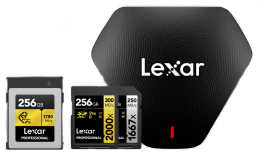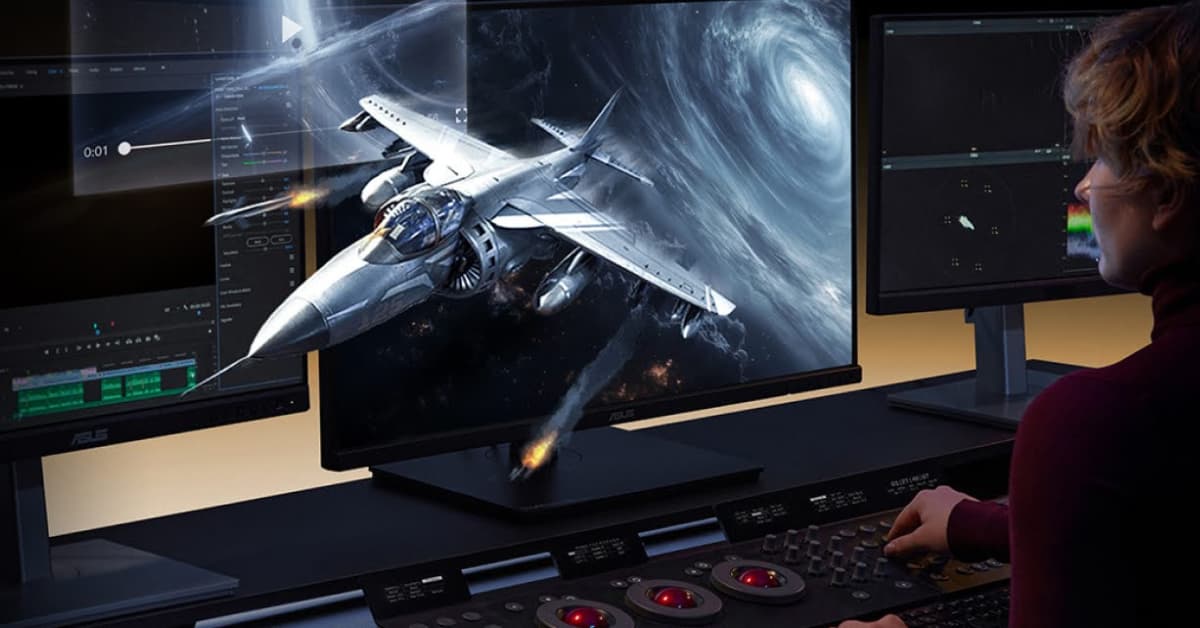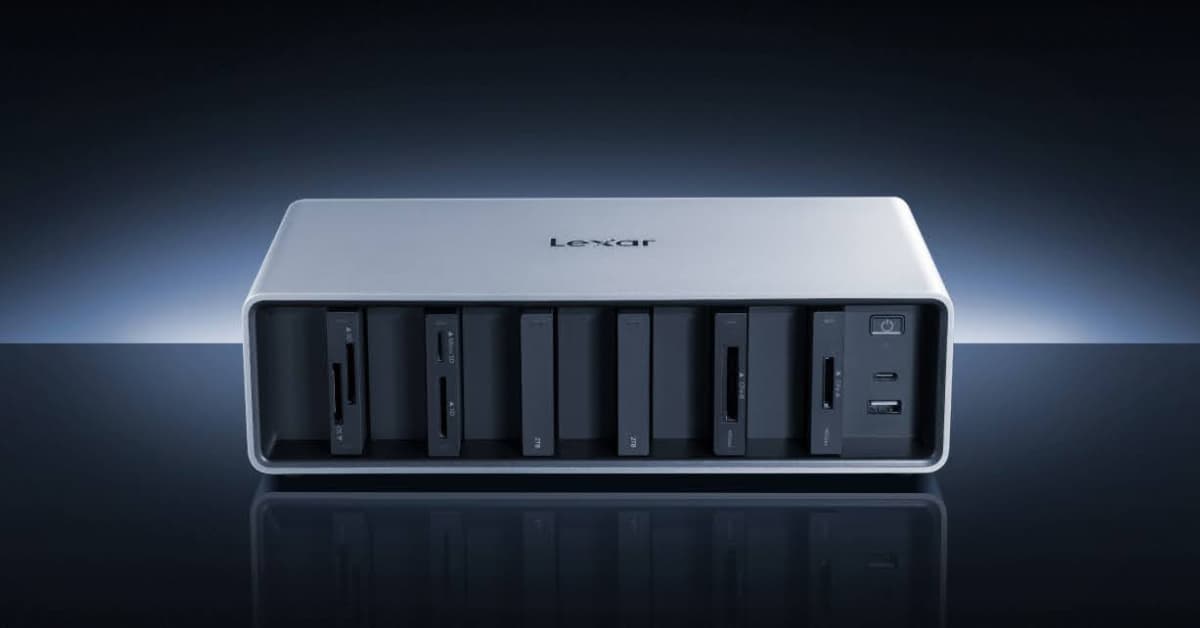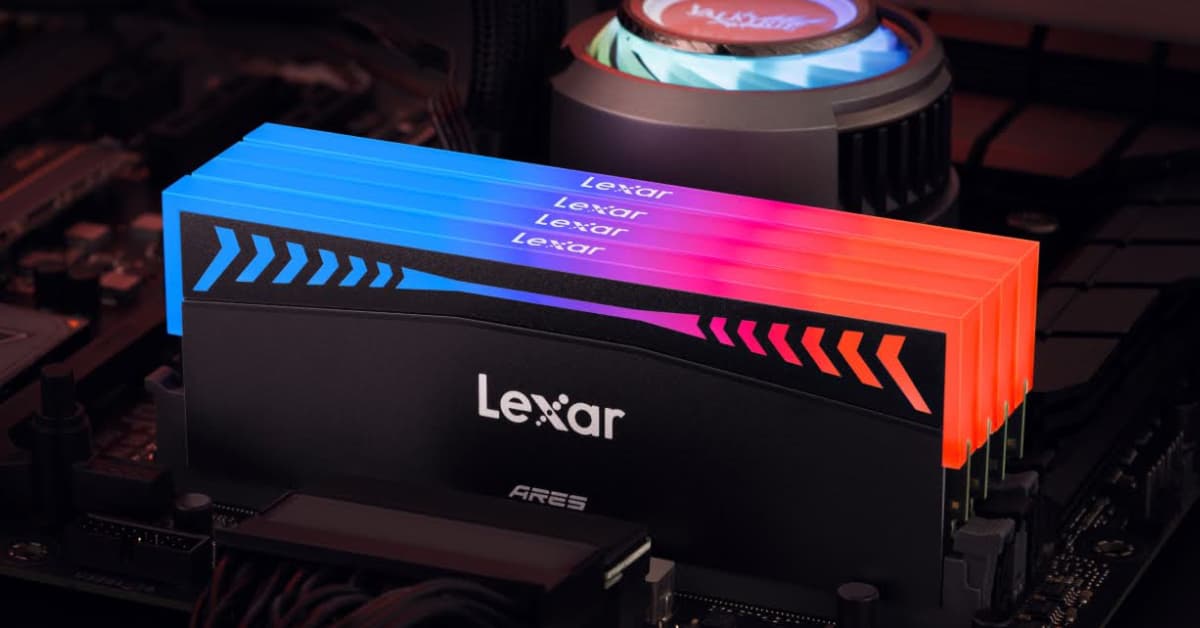
Creators spending thousands on the latest processors and graphics cards often overlook the memory subsystem that connects everything together. When your 4K timeline stutters during playback or your game drops frames during crucial moments, the problem isn’t necessarily your expensive hardware — it’s the memory bottleneck preventing that hardware from reaching its potential.
Your memory choice directly determines whether your high-end system performs like the powerhouse you paid for or struggles like a budget build. With Lexar DDR5 performance, you get a fundamental leap beyond traditional memory constraints, transforming how high-end editing and gaming systems handle intensive workloads.
What Makes Lexar DDR5 Performance Revolutionary?

Lexar DDR5 performance goes far beyond simple speed increases over previous memory generations. While DDR4 topped out around 3200MHz in mainstream applications, DDR5 technology starts at 4800MHz and scales dramatically higher, with the Lexar® ARES RGB 2nd Gen DDR5 Desktop Memory delivering extraordinary frequencies of 8000MT/s and low latency of CL36.
The performance advantage extends beyond raw bandwidth. DDR5 architecture includes on-die error correction code (ECC) for improved stability and reliability, plus on-board power management integrated circuits (PMIC) to enhance power efficiency. These technical improvements translate into measurable real-world benefits for demanding applications.
Advanced power management in Lexar DDR5 solutions reduces motherboard stress while improving system stability. The integrated PMIC handles voltage regulation locally rather than relying on motherboard circuits, enabling more precise power delivery and reducing electrical noise that can impact performance.
Enhanced data integrity through on-die ECC catches and corrects memory errors before they affect your work. During extended rendering sessions or marathon gaming periods, this error correction prevents the subtle data corruption that can cause crashes, artifacts, or corrupted project files.
Massive bandwidth scaling enables true parallel processing for multi-threaded applications. While DDR4 systems struggled to feed data to modern many-core processors, Lexar DDR5 performance provides the throughput needed for processors with 12, 16, or more cores to operate simultaneously without memory starvation.
Why High-End Editing Demands DDR5 Performance
Modern video editing workflows create memory demands that older DDR4 systems simply cannot satisfy. When you’re working with 8K footage, multiple camera angles, color grading, and real-time effects, memory becomes the critical bottleneck that determines whether your timeline plays smoothly or stutters constantly.
Timeline responsiveness improves dramatically with DDR5 bandwidth. Scrubbing through 4K or 8K footage requires massive data throughput, and every frame represents 33MB-132MB of uncompressed data. DDR5 performance ensures your editing software can load and display frames instantly rather than forcing you to wait for cache builds.
Multi-stream processing becomes practical with sufficient memory bandwidth. Professional editors often work with 4-8 camera angles simultaneously, requiring the system to decode and display multiple high-resolution streams in real-time. DDR4 systems frequently drop frames or reduce quality to maintain playback, while DDR5 handles multiple streams without compromise.
Effects processing benefits enormously from DDR5’s low latency characteristics. Real-time color grading, noise reduction, and stabilization require rapid memory access patterns that DDR5 handles far more efficiently than previous generations.
Gaming Performance Transformation with DDR5
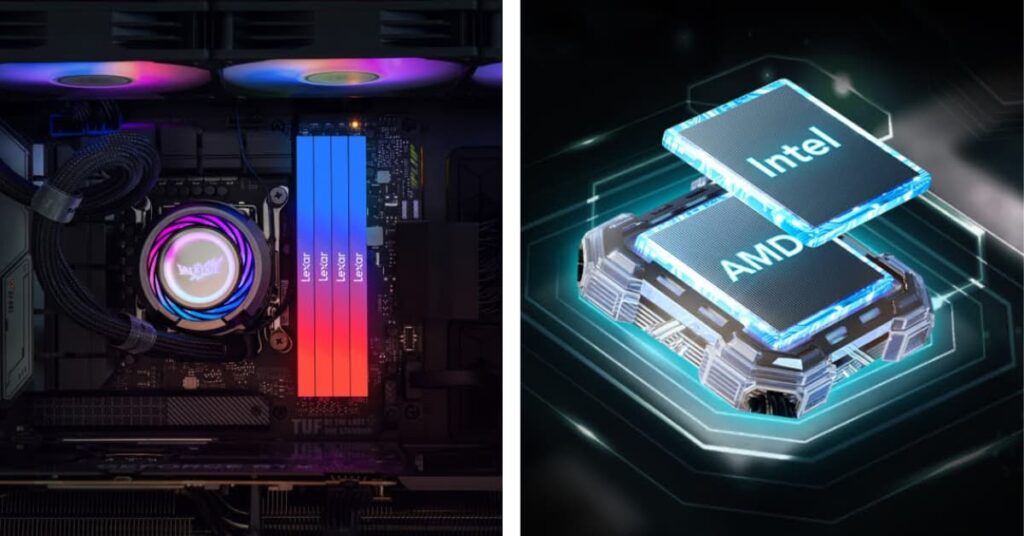
Gaming performance improvements from Lexar DDR5 performance extend far beyond simple frame rate increases. Modern games utilize complex streaming systems, advanced physics calculations, and detailed world simulations that create diverse memory access patterns throughout gameplay.
Frame rate consistency improves significantly with DDR5’s higher bandwidth and lower latency characteristics. While average frame rates might increase by 10%-15%, frame time consistency often improves by 30%-40%, eliminating the stuttering and hitching that disrupts competitive gaming performance.
Lexar® ARES RGB DDR5 Desktop Memory is compatible with the latest Intel XMP 3.0 and AMD EXPO™ profiles, enabling easy overclocking to extract maximum performance from both Intel and AMD gaming systems. This compatibility ensures optimal performance regardless of your processor choice.
Open world performance benefits dramatically from DDR5’s streaming capabilities. Games like Cyberpunk 2077, Assassin’s Creed, and Microsoft Flight Simulator constantly load new world data as you explore. DDR5’s bandwidth ensures these streaming operations don’t cause hitching or texture pop-in during gameplay.
Competitive gaming advantages emerge from DDR5’s consistent low-latency performance. In esports titles where reaction times matter, the improved memory response reduces input lag and provides more stable frame delivery, giving competitive players measurable advantages.
Multi-application gaming becomes more practical with DDR5’s bandwidth headroom. Streaming, recording, or running Discord while gaming no longer requires performance compromises when sufficient memory bandwidth is available.
Lexar DDR5 Product Line Performance Analysis
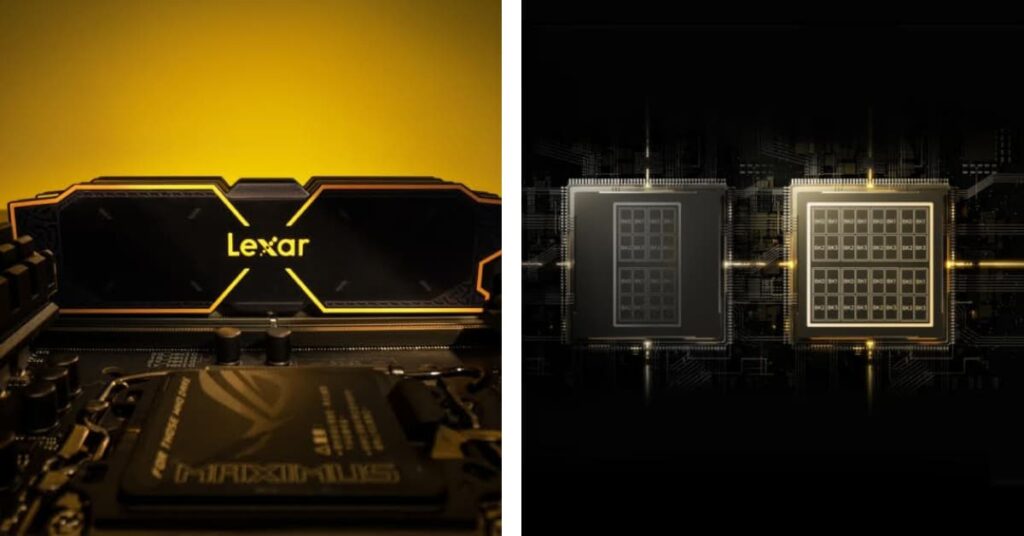
Understanding the performance characteristics of different Lexar DDR5 solutions helps you select the optimal memory configuration for your specific editing and gaming requirements.
Lexar® ARES RGB 2nd Gen DDR5 Desktop Memory represents the pinnacle of Lexar DDR5 performance for enthusiast systems. Equipped with premium SK hynix DRAM chips to enable higher performance and better stability, this memory delivers extraordinary frequencies of 8000MT/s with low latency of CL36 (7600MT/s, 32GB Kit).
The advanced thermal management system includes a 1.88mm-thick heatsink and an exclusive PMIC thermal conductive pad that provides superior thermal conductivity. This cooling solution enables sustained high-performance operation during extended editing sessions or marathon gaming periods without thermal throttling.
Lexar® ARES RGB DDR5 Desktop Memory provides excellent performance for mainstream high-end systems. Compatible with the latest Intel XMP 3.0 and AMD EXPO™ profiles, this memory enables blazing-fast overclocking speeds to elevate your gaming experience while maintaining the stability needed for professional editing work.
The premium aluminum heat spreader design keeps your system running cool, allowing ultra-fast performance under intensive workloads. With Lexar RGB Sync, you can customize and synchronize your lighting effects by color, intensity, and speed to match your system aesthetics.
Lexar® THOR OC DDR5 Desktop Memory offers high-performance capabilities in a compact form factor. At a mere 40mm high, this memory is perfect for compact PC builds or systems with large CPU coolers. At speeds up to 6000MT/s, this memory provides the headroom needed for high-performance gaming and overclocking enthusiasts.
Lexar® DDR5 UDIMM Desktop Memory delivers reliable DDR5 performance for users who prioritize stability and compatibility. With speeds of 4800MHz, it ensures smooth gameplay and efficient multitasking, making it perfect for desktop gaming setups. Its compatibility with Intel XMP 3.0 and AMD EXPO allows for optimized overclocking with ease.
Lexar® DDR5 SODIMM Laptop Memory brings DDR5 technology to mobile workstations and gaming laptops. With speeds of 4800MHz and support for Intel XMP 3.0 and AMD EXPO, it allows for seamless setup and optimized overclocking on both platforms while maintaining the power efficiency crucial for laptop applications.
Technical Architecture Behind DDR5 Performance Gains
Understanding the technical improvements in DDR5 architecture explains why Lexar DDR5 performance provides such significant advantages over previous memory generations.
Doubled bank groups enable more efficient data access patterns. DDR5 includes 32 banks organized into 8 bank groups, compared to DDR4’s 16 banks in 4 groups. This increased parallelism allows the memory controller to serve more simultaneous requests, reducing latency for complex workloads.
Burst length optimization improves efficiency for modern applications. DDR5 uses longer burst lengths (BL16) compared to DDR4’s BL8, reducing the overhead associated with memory commands. This change particularly benefits applications that access large sequential data blocks, common in video editing and game asset streaming.
Improved prefetch architecture enhances predictive data loading. DDR5’s 16n prefetch (compared to DDR4’s 8n) enables better prediction of data access patterns, reducing cache misses and improving overall system responsiveness during complex workloads.
Enhanced command structure reduces latency penalties. DDR5 includes optimized command timing that reduces the delays between different types of memory operations, enabling faster switching between read and write operations crucial for interactive editing and gaming.
Voltage regulation improvements provide cleaner power delivery. The integrated PMIC in Lexar DDR5 solutions handles voltage regulation locally, reducing electrical noise and enabling more stable operation at higher frequencies.
Real-World Performance Benchmarks
Quantifying Lexar DDR5 performance improvements requires testing across various editing and gaming scenarios that reflect actual user workloads rather than synthetic benchmarks alone.
Video editing performance metrics show dramatic improvements across multiple workflow stages:
- 4K Timeline Playback – Lexar DDR5 systems maintain smooth playback at full resolution where DDR4 systems require reduced preview quality
- Color Grading Responsiveness – Real-time LUT applications and color wheel adjustments show 40%-60% faster response times
- Multi-Cam Editing – DDR5 enables smooth 4-camera 4K editing where DDR4 systems struggle with 2-camera setups
- Export Performance – Hardware-accelerated encoding shows 15%-25% faster completion times with adequate memory bandwidth
Gaming performance analysis reveals improvements beyond simple frame rate increases:
- Frame Time Consistency – DDR5 reduces frame time variance by 30%-40%, eliminating stuttering in demanding games
- Loading Time Reduction – Open world games show 20%-30% faster level loading when memory bandwidth isn’t limiting asset streaming
- Minimum Frame Rates – 1% and 0.1% low frame rates improve significantly, reducing perceived performance drops
- Multi-Tasking Performance – Streaming or recording while gaming shows minimal performance impact with adequate DDR5 bandwidth
Professional application benefits extend beyond gaming and video editing:
- 3D Rendering – Complex scenes with high polygon counts and detailed textures benefit from increased memory throughput
- Audio Production – Large sample libraries and real-time plugin processing show reduced latency and improved stability
- Software Development – Compilation times decrease significantly when working with large codebases
- Virtual Machine Performance – Multiple VM instances run more smoothly with adequate memory bandwidth allocation
Optimization Strategies for Maximum DDR5 Performance
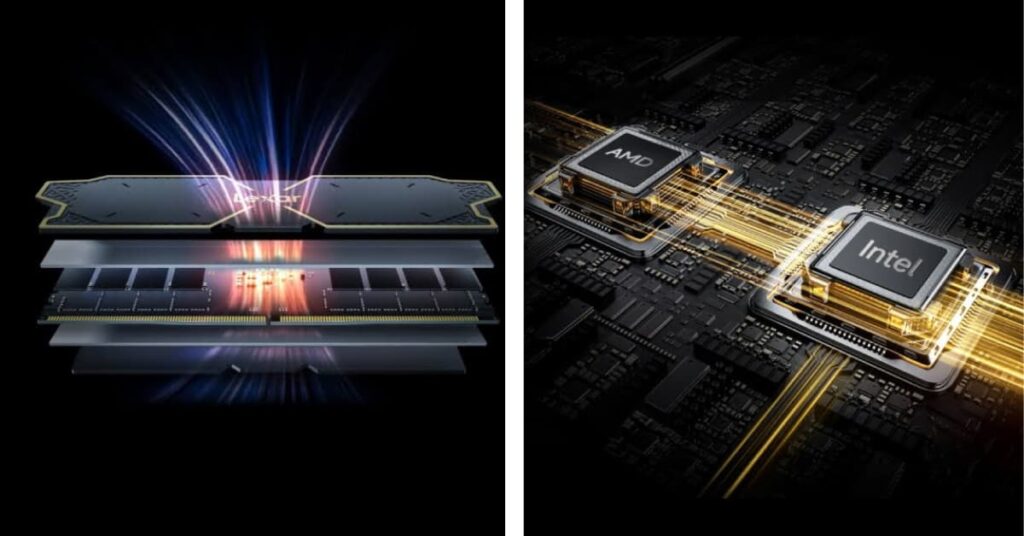
Achieving optimal Lexar DDR5 performance requires proper system configuration and understanding of the technologies that enable peak operation.
XMP 3.0 and EXPO™ Profile Configuration provides the easiest path to high performance. Lexar® ARES RGB DDR5 Desktop Memory is compatible with both Intel XMP 3.0 and AMD EXPO™ standards, enabling automatic optimization for your specific processor and motherboard combination.
XMP 3.0 includes multiple profiles optimized for different use cases – some prioritize maximum bandwidth while others focus on lowest latency. EXPO™ provides similar optimization specifically tuned for AMD processors and their memory controller characteristics.
Memory timing optimization can extract additional performance beyond standard profiles. While automated profiles provide excellent results, manual timing adjustments can provide 5-10% additional performance for users comfortable with advanced BIOS settings.
Thermal management becomes crucial at high DDR5 frequencies. Lexar® ARES RGB 2nd Gen DDR5 Desktop Memory includes sophisticated cooling solutions, but proper case airflow ensures sustained performance during extended workloads.
Capacity planning affects performance beyond simple multitasking capability. Modern editing applications and games benefit from having adequate RAM to cache frequently accessed data, reducing storage system load and improving overall responsiveness.
Dual-channel configuration remains essential for optimal performance. Single-channel DDR5 configurations sacrifice significant bandwidth, negating many of the technology’s advantages. Always use matched pairs or kits for optimal performance.
Compatibility and Integration Considerations
Maximizing Lexar DDR5 performance requires understanding compatibility requirements and integration considerations for both Intel and AMD platforms.
Intel platform optimization varies significantly between processor generations. 12th generation and newer Intel processors provide native DDR5 support with optimal memory controllers, while some earlier generations may require specific motherboard implementations for best results.
AMD platform considerations show different memory scaling characteristics. AMD’s Infinity Fabric architecture benefits significantly from high-speed memory, making DDR5’s bandwidth particularly valuable for Ryzen processors in both gaming and productivity applications.
Motherboard selection impacts achievable performance significantly. High-end motherboards with robust memory circuitry can achieve higher overclocked frequencies and maintain stability during demanding workloads, while budget boards may limit peak performance.
Memory slot population affects maximum achievable frequencies. Two-DIMM configurations typically achieve higher frequencies than four-DIMM setups due to reduced electrical loading on the memory controller.
Mixed configuration Compatibility requires careful consideration. While mixing different DDR5 modules is possible, using matched kits like Lexar® ARES RGB DDR5 Desktop Memory ensures optimal compatibility and performance.
Future-Proofing Your System with DDR5 Technology
Investing in Lexar DDR5 performance provides significant future-proofing advantages as software applications and games increasingly demand higher memory bandwidth and lower latency for optimal operation.
Evolving software requirements continue pushing memory bandwidth demands higher. Video editing applications now support 8K workflows as standard, while games implement more sophisticated streaming systems and detailed physics simulations. DDR5’s bandwidth headroom ensures your system remains capable as these requirements grow.
Next-generation gaming engines are being designed with DDR5 capabilities in mind. Unreal Engine 5’s Nanite virtualized geometry and Lumen global illumination systems require massive memory throughput for optimal performance. DirectStorage and similar technologies reduce CPU overhead but increase memory bandwidth requirements for game asset streaming.
AI and machine learning integration in creative applications creates new memory performance demands. Real-time AI noise reduction, automated color matching, and content-aware editing features require substantial memory bandwidth to process data efficiently without interrupting creative workflows.
Multi-monitor and high-refresh gaming trends increase memory throughput requirements. 4K gaming at 120Hz or 1440p at 240Hz creates sustained high-bandwidth demands that DDR4 systems struggle to satisfy, while DDR5 provides comfortable headroom for these demanding scenarios.
Making the Right DDR5 Choice for Your Needs

Selecting the optimal Lexar DDR5 configuration requires matching memory specifications to your specific performance requirements and budget constraints.
High-End Content Creation demands maximum performance configurations. Lexar® ARES RGB 2nd Gen DDR5 Desktop Memory with 8000MT/s performance provides the bandwidth needed for 8K editing, complex motion graphics, and professional rendering workflows.
Competitive Gaming Systems benefit from balanced performance and latency optimization. Lexar® ARES RGB DDR5 Desktop Memory with XMP 3.0 and AMD EXPO™ compatibility provides excellent gaming performance with the overclocking headroom needed for competitive advantages.
Professional Workstations require proven stability alongside high performance. Lexar® DDR5 UDIMM Desktop Memory offers reliable DDR5 performance for business-critical applications where stability outweighs maximum performance.
Laptop and Mobile Workstations need performance within power constraints. Lexar® DDR5 SODIMM Laptop Memory brings DDR5 technology to mobile systems while maintaining the power efficiency crucial for battery life.
Compact and Small Form Factor Builds benefit from space-efficient solutions. Lexar® THOR OC DDR5 Desktop Memory provides high performance in a compact form factor suitable for mini-ITX builds and systems with large CPU coolers.
All Lexar products undergo extensive testing in the Lexar Quality Labs, facilities with thousands of different cameras and digital devices to ensure performance, quality, compatibility, and reliability across diverse system configurations and use cases.
Your Next Steps to DDR5 Performance Excellence
Transitioning to Lexar DDR5 performance requires strategic planning and systematic implementation to ensure optimal results and maximum return on investment.
Performance assessment starts with understanding your current system limitations. Monitor memory utilization during typical workloads to identify whether memory bandwidth is constraining your productivity or gaming performance.
Use system monitoring tools to track memory usage patterns, identify peak bandwidth demands, and determine whether your current memory configuration adequately supports your workflows.
Configuration planning involves selecting the optimal DDR5 solution for your specific requirements. High-end content creation workflows benefit from maximum performance configurations like the Lexar® ARES RGB 2nd Gen DDR5 Desktop Memory, while balanced gaming systems might prioritize the Lexar® ARES RGB DDR5 Desktop Memory with its excellent overclocking capabilities.
System integration strategy ensures DDR5 upgrades complement other system components effectively. Verify motherboard compatibility, ensure adequate cooling for high-performance configurations, and plan any other component upgrades needed to maximize DDR5 benefits.
Performance validation confirms that DDR5 upgrades deliver expected improvements. Test system performance before and after upgrades using real-world workloads rather than synthetic benchmarks alone.
Professionals and enthusiasts who understand memory performance as a critical system component are the ones whose systems operate at peak efficiency. They’re the ones whose editing workflows never stutter, whose games never drop frames, and whose systems remain responsive under the heaviest workloads.
Lexar DDR5 performance isn’t just faster memory — it’s the foundation for professional workflows and gaming systems that support your goals rather than limiting your potential.
Your projects deserve the responsiveness and reliability that DDR5 technology provides. Your competitive gaming deserves the consistency and low latency that eliminates performance variability. Your professional reputation deserves systems that never become the bottleneck preventing you from delivering your best work.
Choose outdated memory technology, and watch your investment underperform. Choose Lexar DDR5 performance solutions, and unlock the full capability of modern editing and gaming systems.

